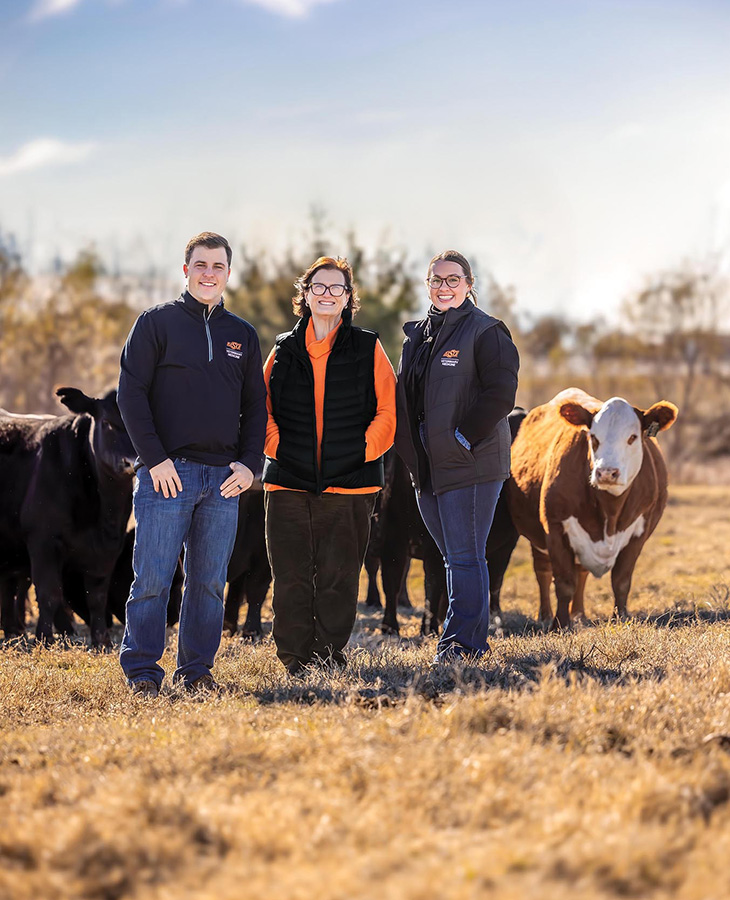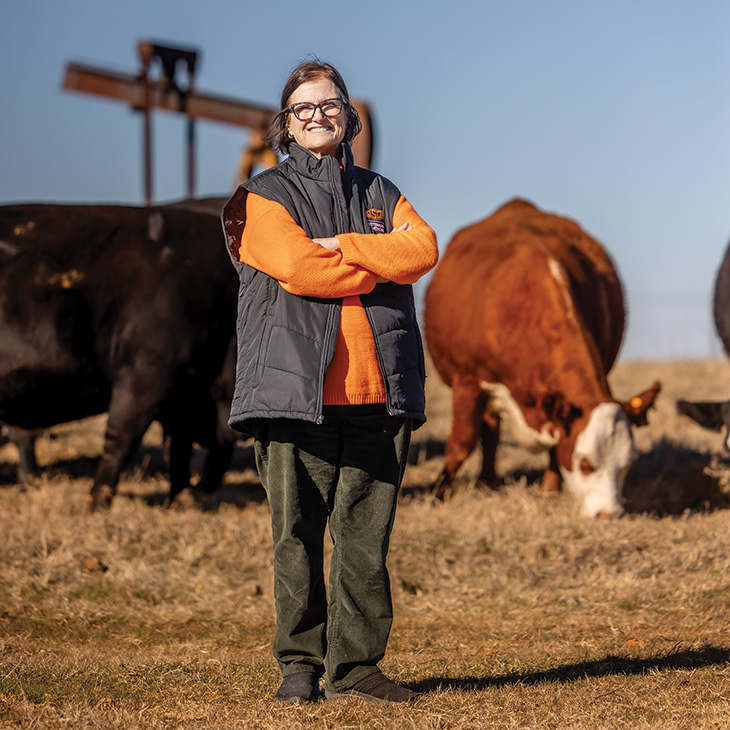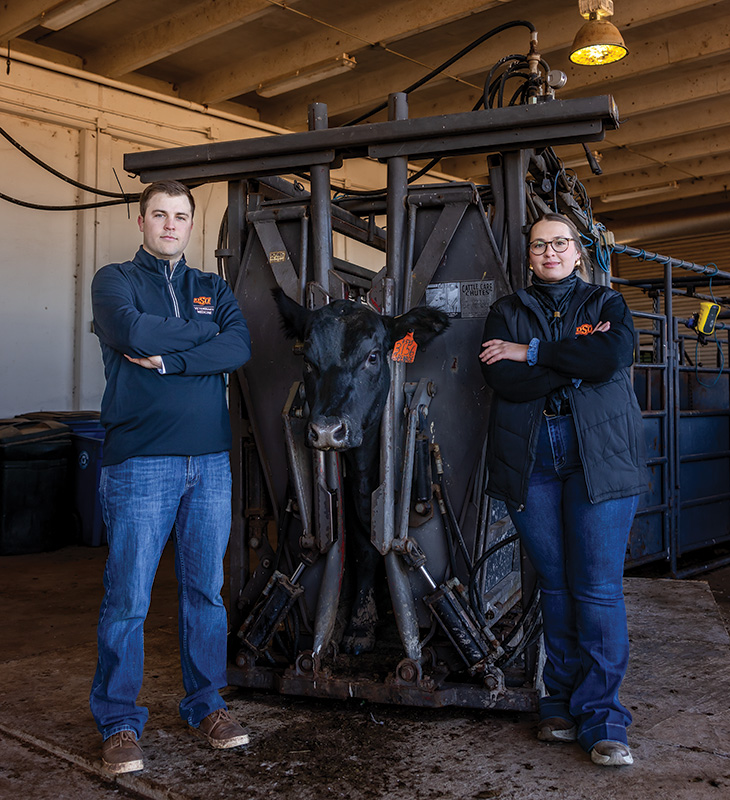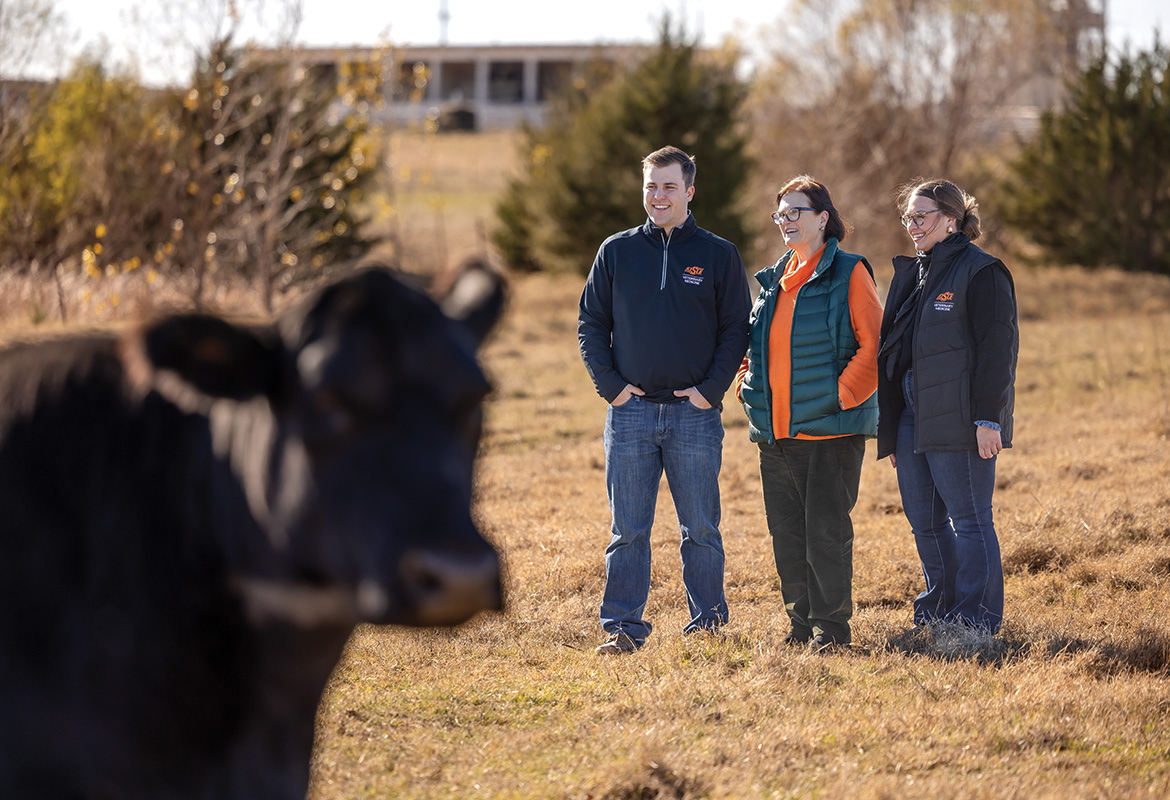
Shaping Rural Vet Med's Future: First group of scholarship awardees prepare to aid areas in need
Thursday, January 2, 2025
Media Contact: Taylor Bacon | Public Relations and Marketing Manager | 405-744-6728 | cvmcommunications@okstate.edu
In the quiet corners of rural America, where the nearest neighbor may be miles away, a small but vital group of professionals keeps the heartbeat of agriculture steady.
They are the rural veterinarians — often working long hours, in all weather, sometimes with little fanfare — tending to the animals that provide food, fiber and livelihood to thousands of families.
The work is demanding, but the rewards are often intangible, rooted in the deep relationships veterinarians build with the farmers and ranchers who depend on them. Rural veterinarians are not just animal practitioners; they are embedded in the communities they serve and are integral parts of the fabric of rural America.
At the Oklahoma State University College of Veterinary Medicine, cultivating the next generation of rural veterinarians is a top priority.
“At OSU, we are deeply committed to producing practice-ready large and mixed animal veterinarians who can step directly into the field and make an impact,” said Dr. Rosslyn Biggs, CVM assistant professor and director of the Oklahoma Rural Veterinary Scholarship and Loan Forgiveness Program. “We know these veterinarians play a critical role in rural communities, and we want to ensure our graduates are prepared to meet the unique challenges of rural practice with confidence.”
This summer, the Oklahoma Legislative and Executive branches passed HB 3196 — the Dr. Lee Denney Act. It was created to provide financial support for students pursuing a Doctor of Veterinary Medicine degree at OSU to practice in rural Oklahoma communities and receive training to meet the needs of livestock producers.
“Through this scholarship program, we’re not just training veterinarians; we’re cultivating
the future of rural Oklahoma.”
Denney, a 1978 CVM alumna, expanded her horizons from the veterinary realm to go into public service. Throughout her illustrious career, she also served as the speaker pro tempore in the Oklahoma House of Representatives.
“For far too long, our rural communities have struggled with a critical shortage of veterinarians who understand the challenges of agricultural livestock,” Denney said. “This bill isn’t just about financial support for students — it’s about sustaining the lifeblood of Oklahoma’s agricultural economy. By investing in these young veterinarians, we’re ensuring that our farmers and ranchers will continue to have the essential professional support they need to maintain healthy herds and profitable operations.

“Through this scholarship program, we’re not just training veterinarians; we’re cultivating the future of rural Oklahoma.”
The scholarship program prioritizes Oklahoma residents who are passionate about large animal care and committed to practicing in communities with populations of 25,000 or fewer. The scholarships are designated up to $25,000 annually for up to four years.
“We are incredibly grateful to the Oklahoma Legislature for their support of our college, students and rural Oklahoma,” Biggs said. “It’s not just an investment in education; it’s an investment that will support Oklahoma agriculture and strengthen our rural communities.”
The first scholarship recipients from the Oklahoma Rural Veterinary Scholarship and Loan Forgiveness Program are class of 2025 students Taylor Cartmell, Lauren Dixon, Jacob Gollihare, Mandy Lawson and Will Shelby, along with class of 2026 students Cassidy Barry, Noah Edwards and Eli Pool.
“Rural veterinary medicine is something I believe is a crucial part of our state,” Shelby said. “Not only do I feel like I can make a difference in the role as a rural veterinarian, but something I believe is one of the biggest joys of this career path is the personal relationships you get to build with your clients.”
As an Oklahoma resident from a rural, farming community, Dixon is passionate about helping farmers and ranchers.
“Growing up on a commercial cattle ranch in Wyandotte, Oklahoma, I was able to see all aspects of the industry and fell in love with herd health,” Dixon said. “It was a fascinating concept to me that even the smallest of changes in a herd health management program could make a large impact on production and profitability.”
Since attending OSU CVM, Dixon has only grown her passion for this area of veterinary medicine.
“If you would have asked me when I began veterinary school why I wanted to be a vet, it would have been a simple answer of I like animals and want to help them,” she said. “Going through school and truly finding a passion for food animal medicine, my answer to this question now would be that veterinary medicine is crucial to the forward progression of the food animal industry, and I want to be a part of that.”

Some students, like Cartmell, witnessed firsthand the shortage of rural veterinarians.
“Being raised in Oklahoma, I was quickly exposed to the shortage of veterinarians in rural communities,” Cartmell said. “This inspired me to pursue rural veterinary care and help mitigate some of the shortage.”
As a fifth-generation farmer, Edwards experienced similar challenges raising cattle in western Oklahoma. Growing up near Calumet and having farms in Carnegie, Edwards said he’s had to drive an hour to have a cow checked. He’s also had times where there was no available veterinarian at all. He recognizes the problem and said he hopes to be a part of the solution.
For these students, OSU was the perfect fit for pursuing their dreams and supporting them in becoming large animal veterinarians.
“OSU has supported me in my journey to becoming a mixed animal veterinarian by offering core and elective classes that not only focus on the knowledge of treating production animals but also the hands-on experience I will need after graduation,” Barry said.
Many recipients attributed their success to the guidance and mentorship of the exceptional faculty members at OSU CVM.
“Individuals like Drs. Rosslyn Biggs, Lionel Dawson and Jared Taylor are invaluable assets to their students,” Lawson said. “The foundational relationships built with them serve us in so many capacities. From recommendations for externships and introduction to future peers at conferences, I will never be able to put into words the full impact they have had on me and my education.”
Students are prepared for their careers through a blend of rigorous classroom instruction and a wide range of extracurricular opportunities that allow them to practice and refine their skills outside of the classroom.
“OSU CVM has an outstanding system of clubs and organizations, many of which are large animal-based,” Pool said. “It is through these organizations as well as large animal electives that I have been able to expand my clinical understanding and skills to be prepared as a fourth-year student heading into clinical rotations.”
As the recipients reflected on their veterinary school experiences and the support received through this program, they expressed gratitude for the individuals and organizations who made this opportunity possible.
“This program is a blessing, not only to myself as being one of the first to receive this award, but also for future recipients who are looking to begin a career in rural veterinary medicine,” Dixon said. “This award will allow me to begin my career with financial stability and reduce the burden of my student loans.”

Dixon plans to pay it forward by advocating for animal health in her community. Edwards echoed her sentiments.
“It is a huge blessing to my family and me,” he said. “It feels like a giant weight has been lifted off my shoulders.”
Shelby described this experience as a huge honor.
“This is something I don’t take lightly, and I hope that I can contribute to the state’s need for rural veterinarians in a quality way,” he said.
He plans to return to southern Oklahoma and open a food animal practice.
“Growing up, I was fortunate enough to get to follow my dad around quite often on his workdays as a food animal veterinarian,” he said. “I saw the difference and relationships that are products of an involved food animal veterinarian, and the culmination of these things helped me decide this was the career for me.”
Lawson is looking forward to developing strong roots in the community she ends up in and building relationships with the producers she’ll be working with.
“I believe that as a veterinarian in a rural community, I have the distinct opportunity to pour into and invest in the next generation of agriculturists as they begin realizing and pursuing their dreams,” Lawson said. “Through striving for excellence and looking for opportunities to be a value-added asset to the students, community members and producers I am working with and for, I am eager to be able to give back to my community.”
Photos By: Ellie Piper
Story By: Taylor Bacon | Vet Cetera Magazine
